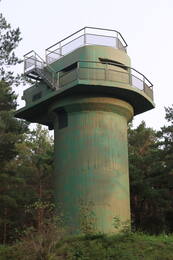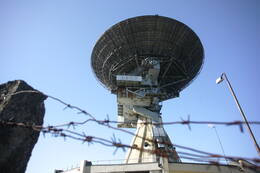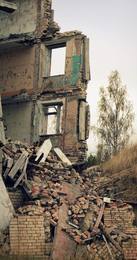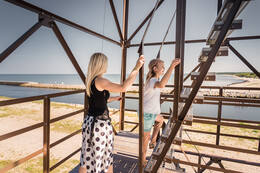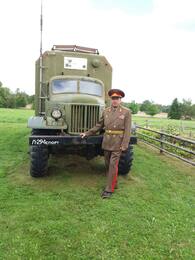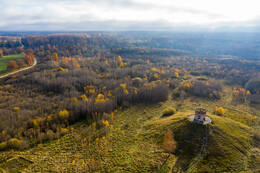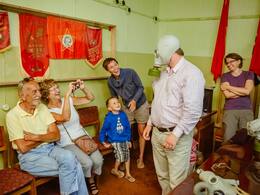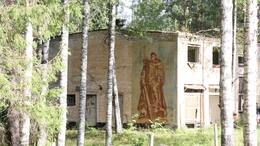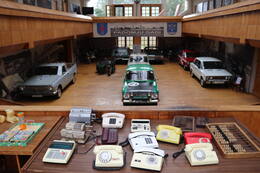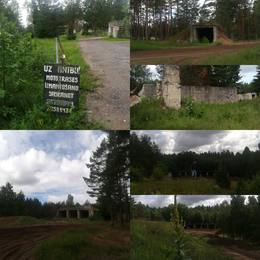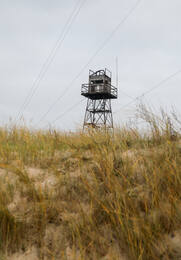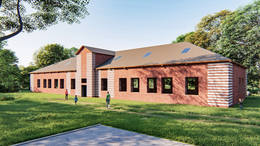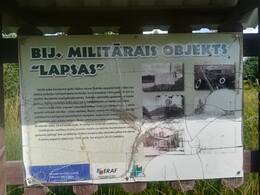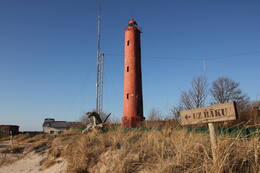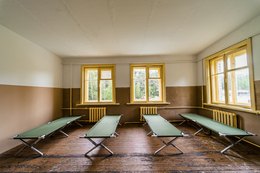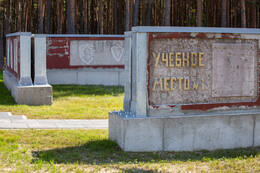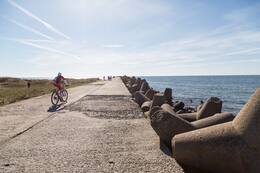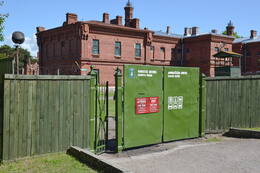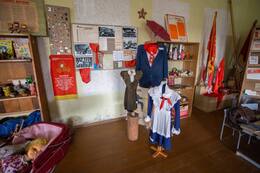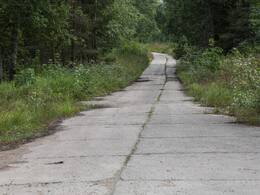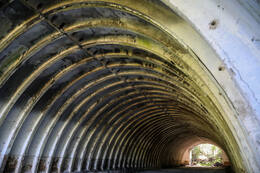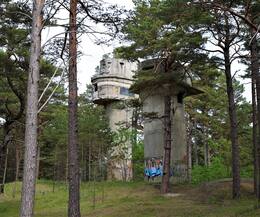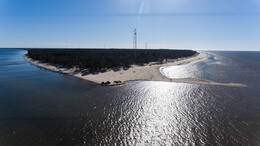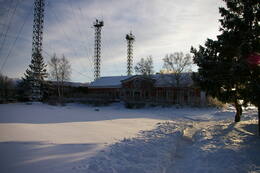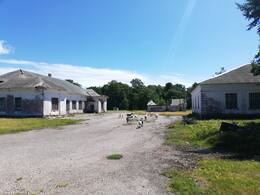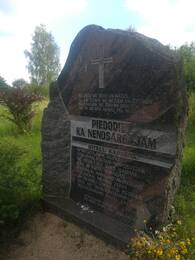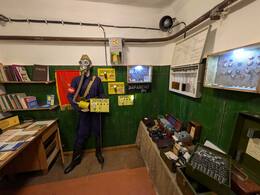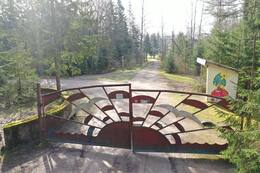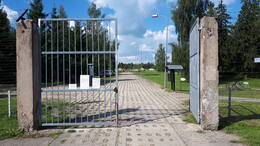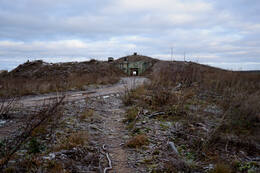Šaltasis karas
IV Sovietų okupacija, Atkurta Nepriklausomybė
Šaltasis karas (an. Cold War, vc. Kalter Krieg, fr. Guerre froide, kr. холодная война) – priešiška politinė ir ekonominė konfrontacija XX a. antroje pusėje tarp SSRS ir jos satelitinių šalių iš vienos pusės ir Vakarų šalių iš kitos.
Jis datuojamas 1946 m. kovo 5 d., kai buvęs Didžiosios Britanijos ministras pirmininkas Winstonas Churchillis savo kalboje Fultone (JAV) postulavo, kad Europa dėl ideologinių prieštaravimų buvo padalinta „geležine uždanga“ tarp sovietų okupuotos zonos ir likusios Europos. Nuo tada terminas „geležinė uždanga“ buvo vartojamas kaip takoskyra tarp SSRS įtakos sferos ir Vakarų šalių visame pasaulyje. JAV ir SSRS konkuravo tarpusavyje, provokuodamos ar dalyvaudamos kariniuose konfliktuose įvairiose pasaulio vietose, kurdamos satelitinius režimus, ieškodamos naujų sąjungininkų, konkuruodamos ekonomiškai ir politiškai, keisdamosi kaltinimais, siekdamos padidinti savo įtaką mažindamos kitos pusės įtaką.
Ši konkurencija išlaikė bendrą politinės destabilizacijos jausmą pasaulyje iki devintojo dešimtmečio pabaigos, kai SSRS ekonomika nesugebėjo konkuruoti ir žlugo.
Daugiau informacijos šaltinių
Kaip ir kodėl prasidėjo Šaltasis karas? / Straipsnis (lsm.lv)
Šaltasis karas – Vikipedija (wikipedia.org)
Susijusi laiko juosta
Susijusios vietos
Fire correction tower of the Ventspils 46th Coastal Defence Battery
The restored fire control tower of the 46th Coast Guard Battery in Ventspils is located on Saulrieta street and is available to visitors in the form of an observation tower. There are four artillery gun positions near the tower and it is the only World War II coastal defence battery in Latvia in such a good condition. Visitors can take the tower stairs to an outdoor viewing platform overlooking the sea. An information stand with a QR code is available next to the tower. You can use the QR to watch an animation about historical events. There is a new street leading to the tower, a large parking lot and a wooden footbridge that crosses the protected nature area next to the tower.
This military complex was built in 1939, marking the start of construction of USSR military bases in Latvia. The 46th Coast Guard Battery had four positions for the gun type Б-13. This battery had its first military engagement on 24 June 1941, when Ventspils harbour was attacked by German torpedo boats that were driven away from the shores of the Baltic Sea by battery fire. On June 28 the Soviet Army blew up the guns and left.
Zvaigznīte - Irbene military buildings
The 200-hectare site was once a top-secret military base occupied by military unit 51429.
Former Soviet border guard observation tower in Pāvilosta
The Soviet border guard observation tower is located near the South Pier in Pāvilosta. The former Soviet border guard observation tower, which had been out of use since the early 1990s, now serves as a viewing platform with a 360-degree rotating land telescope. It offers beautiful views of the sea and ships and can be used for bird watching. Ascending the tower is only allowed during daylight hours in the summer season. As the stairs in the tower are quite steep, visitors should evaluate their abilities, health and associated risks. The observation tower and the surrounding area has video surveillance. The tower is closed to visitors during the winter season.
Sovietų armijos automobilių kolekcija
Edgars Kārklevalks owns a guest house called Pūpoli in the Dundaga region, and for more than 15 years he has been taking people on historical and educational trips around northern Kurzeme (including to former military areas) with his own renovated Soviet Army truck GAZ-66 (up to 24 persons) and UAZ-3151 (up to 6 persons). Soviet Army trucks and other equipment are showcased in an area around the guest house.
Soviet Army Observation Tower (Kurgan of Officers)
The "Officers' Kurgan" is located less than a kilometre from the ruins of Zvārde Church. The Kurgan is made of the ruins and remains of the surrounding houses and manor house, which have been bulldozed together. An observation tower was built on the kurgan. According to the inscription, the present tower was built in 1981. The tower was used to record bomb hits. The training bombs had a reduced explosive content, so their hits had to be watched more carefully. Unexploded bombs were neutralized immediately, but not all could be found.
The remains of the tower can be seen here today - the brick walls. As the barrage is relatively high, you can even see the Lithuanian oil refinery in Mažeikiai on a clear day.
Secret Soviet Bunker in Līgatne
Located in Līgatne parish, Cēsis municipality, the Soviet Secret Bunker lies 9 metres below the Līgatne Rehabilitation Centre building and its adjacent territory. The bunker is open to visitors and offers guided tours, meals in the bunker canteen, Soviet-style parties and the reality game Object X. The purpose of the bunker was to provide the minimum necessary conditions for long-term work for the Council of Ministers of the Latvian SSR, the leadership of the Communist Council of the LSSR and the management of the LSSR state planning committee in the event of a nuclear war threat. The 2,000-square-metre underground bunker was the strongest autonomous structure with all the required and most state-of-the-art equipment of the time, and also one of the most strategically important sites in Soviet-era Latvia in the event of a nuclear war. The site has a protected underground workspace (shelter), a sanatorium-type sleeping block for 250 people, security facilities and a 24-apartment residential house for service staff. All of the authentic underground equipment and plans have been preserved to this day. Highlights include an autonomous power plant with diesel generators and fuel storage, conditioning equipment for air purification with oxygen reserves, water supply and sewerage equipment operating on the submarine principle, a telecommunications unit capable of providing direct contact with the Kremlin in Moscow and autonomous communications with all major services in the country, a unique map with historical names of collective farms, an authentic canteen with typical Soviet-era meals, as well as various Soviet-era attributes and household items.
Soviet Army Missile base in Zeltiņi
The former Soviet Army Missile Base is located in Medņukalni, Zeltiņi parish, Alūksne municipality. This nuclear missile base was a particularly secret military facility of the Soviet Army, and it operated in Zeltiņi, Alūksne municipality, from 1961 to 1989. The facility housed P-12 (8K63) and P12Y (8K63Y) surface-to-surface medium-range ballistic missiles with 4 launch pads. Their travel distance was 2,200 kilometres. During this period the army used barbed-wire to secure an area of about 300 ha less than a kilometre from the Sinole-Silakrogs P34 national regional highway. The living and top-secret areas have remained a legacy even today. Concrete roads lead to places hidden from the eye at that time: hangars, launch pads and bomb shelters. Various structures for the maintenance and servicing of nuclear missiles are located on an area of dozens of hectares. Facilities providing the area with the autonomous supply of power, water and heat were destroyed with the withdrawal of the army. After the army left, some of the equipment was handed over to the local municipality. Visitors currently have access to 20 ha of the former territory of the missile base, the south-western part of which is a tourist attraction. Tourists visiting the base can choose between the core exhibit about the history of the missile base, which is located in the Zeltiņi Museum, and a tourist route in the base area. Friends in a group of up to 12 people can enjoy a game of laser tag here.
Aizkraukle museum of History and Art, exposition "Soviet years"
The exhibit is located in the former culture house of Aizkraukle parish. It reflects the everyday social, recreational, professional, educational and cultural life in Soviet times, as well as the history of how Aizkraukle (during Soviet times – Stučka) and the Pļaviņu HPP came to be. Visitors can view the ‘Red Corner’ with its historical propaganda materials, the office of a party functionary and a typical Soviet apartment with a living room, kitchen, bathroom and toilet and their corresponding attributes. Some rooms are dedicated to Soviet medicine, tourism and sports as well as repression tactics. There is a spacious hall in the centre of the exhibit for Soviet-made vehicles. This was started in 2016 by the Aizkraukle History and Art Museum by setting up the exhibit on three floors. Nowadays it is the largest exhibit in the Baltics dedicated to this period of Soviet occupation.
Former Soviet army missile base "Raketnieki"
The former Soviet army base buildings are in a state of disrepair, but there is a motor track on the site. The area can be explored on foot, but good footwear against mud and sand is required.
Soviet border guard post in Jūrmalciems
After the Second World War, Latvia had various prohibitions in border and coastal areas. From 19 June 1945, fishermen were assigned piers, which were fenced off with barbed wire, guarded by patrols and watchtowers. On 4 September 1946, the prohibited coast guard zones on the Western border of the LSSR were introduced.
In Jūrmalci village there is a former border guard control post, a tower and a tractor proudly rocking on the beach! How it got there is something to ask the local guides!
A fabulously beautiful and interesting place - both with its Soviet-era aura and the charm of the seashore.
Olman Battery No.456 (Soviet military base "Krasnoflotska")
The first coastal defence batteries for the defence of the Irbe Strait were built after 1912, when the Baltic Fleet Mine-Artillery Defence Position Plan was approved, which included several coastal defence batteries and sea mine-laying.
The Irbe Strait position was the furthest south, and its task was to block any enemy access to the Gulf of Riga. The main emphasis was on sea mines, tens of thousands of which were laid in the Irbe Strait during WWI by ships of the Baltic Fleet. It was not until 1916 that coastal defence batteries began to be built on the southern tip of the island of Saaremaa, Cape Sorve. Seven batteries were built in total, and Battery 43 was equipped with 305 mm guns. No defence batteries were built on the Latvian coast of the Irbe Strait.
Even after the establishment of the Republic of Latvia, the Latvian army and navy did not establish artillery positions to defend the Irbe Strait.
The situation changed after the mutual assistance pact between the Republic of Latvia and the USSR of 5 October 1939, which provided for a contingent of the Red Army and the Baltic Naval Fleet to be stationed in Kurzeme. Soviet plans also included the establishment of a coastal defence system based on the 1912 plan, with improvements. The plan was to build coastal defence batteries on the site of the Liepaja fortress, with new batteries south of Ventspils (Battery No 46) and two batteries in the narrowest part of the Irbe Strait near Mikeltornis. Already after the occupation and annexation of Latvia, the coastal defence plans of the Baltic Navy were supplemented and by June 1941 the 207th Artillery Division with five batteries was planned to be established in the northern part of Kurzeme. Two batteries were to be set up in the vicinity of Mikeltornis - Battery 40 at Lūžņa with 130 mm B-13 guns in reinforced concrete fortifications, and Battery 117 at Olmani (a place designated on Latvian army maps as Ķesteri) with 152 mm MU-2 guns. As the development of the 152 mm guns was not completed, temporary wooden platforms were built on the reinforced concrete fortifications of the battery and four more 130 mm guns were installed. Both batteries were completed by June 1941, but the batteries could not be traced in the war against the German 291st Infantry Division, and their crews moved to the island of Saaremaa.
At the end of WWII, the German Army Group "Courland" was quite serious about possible Soviet landings in northern Courland, especially after the ice melted in the Gulf of Finland and on the west coast of Estonia. Improvised coastal defence batteries were deployed all along the Kurzeme coast. The Soviet Battery No 40, Gerate Batterie Sommer of the 289th Artillery Division with two 122 mm Soviet howitzers, was stationed in reinforced concrete positions near Luzhne. In the area of Battery 117's position was Battery 2 of the 530th Artillery Division with three 152 mm Soviet trophy guns, three 37 mm zenith drones, one 20 mm four-barrel zenith drones, two 75 mm anti-tank guns and two mortars for illumination.
After the end of active hostilities in May 1945, the USSR began to rebuild the coastal defence system on the Kurzeme coast. In the autumn of 1945, a temporary Battery 456 with 152 mm guns of the Kane system was deployed near the Olmaņi farm, which was renamed "Krasnoflotskaya".
In 1952, the temporary guns of the battery were replaced by the latest 152 mm MU-2 weapon systems. The battery consisted of four reinforced concrete gun emplacements, a reinforced concrete command post with a range-finder turret and technical buildings. The construction of the battery was completed in 1958.
In 1958, after the dismantling of the Lūžņa coastal defence battery, it was replaced by a mobile 130 mm SM-4-1 gun Battery No 343. The mobile guns did not have reinforced concrete gun emplacements, but several log and sand structures were built.
Battery 343 operated until the early 1960s, and Battery 456 until 1975, when it was preserved. The battery positions were used to deploy S-125 air defence missile complexes, as well as the 10th Coastal Defence Artillery-Missile Regiment with CP-2 Sopka missile complexes, and the infrastructure was modified accordingly.
The Soviet Army transferred the infrastructure of the Olmaņi and Lūžņa batteries to the Republic of Latvia in 1993.
Zvārde shooting range and former Soviet military base "Lapsas"
The landfill's service base is located approximately 2 kilometres east of Striķu Manor, on the Saldus-Auce road. The former Soviet Military Aviation Target Range (military unit No 15439) in Zvārde is located south of Saldus. The territory of the airfield is home to several sights - the ruins of Zvārde and Ķerkliņi churches, the ruined Rīteļi cemetery, the observation post of the airfield, the so-called "Officers' Kurgan" and the former airfield personnel base and shooting range "Lapsas".
The Zvārde air target range required a unit of approximately one company to service the air target range - to install targets, repair damage, guard the air target range and coordinate air flights. It was based on the site of the house called "Lapsas" until the Second World War. With the construction of the airfield, barracks, transport sheds, a flight control tower and a firing range for training personnel were built.
After Latvia regained its independence, the Zvārde Defence Forces Training Centre operated here, but since 2007 the site has been owned by the municipality and leased by several hunting collectives. The former barracks house an exhibition on the history of Zvārde parish.
Akmeņrags Lighthouse and the fate of the "Saratov"
The Akmeņrags Lighthouse is located in Saka parish, 10 kilometres southwest of Pāvilosta. The top of the lighthouse can be reached by a spiral staircase and it offers views of the sea and the surrounding forests. Standing at 37 metres high, the current lighthouse tower was built in 1921, while the previous lighthouse was destroyed during World War I.
The Akmeņrags Lighthouse stands out among other lighthouses in Latvia, as it is located in one of the most dangerous places for sailing in the entire Baltic Sea coast. The signal beam of the lighthouse marks a rocky bank, which extends approximately two nautical miles or 3.7 kilometres into the sea in a north-western direction. The depth of the bank is just over two metres. The location of the lighthouse has remained unchanged, but the coastline has been receding over the years. Although a navigation light has been here since 1879, Akmeņrags has seen several shipwrecks. The most notable occurred in September 1923 when a Latvian steamer named Saratow struck the ground. In 1919, Saratow briefly served as the seat of the Latvian Provisional Government. Akmeņrags used to be home to a border guard post, and buildings of the Soviet Army are can be viewed here.
Soviet army military base in Pāvilosta - active recreation centre
During the Soviet era, a border guard unit was located here, other Soviet army units - liaison officers and a surface-to-air missile base were located several kilometres away in the forest. After independence, the Latvian army was stationed there.
The former Soviet army military base is now a recreation, leisure and camping centre - for personal development in interaction with nature and the people around.
A place for recreation and accommodation for both tourist groups and families. Rooms, showers, WC, fireplaces, spacious area for activities, sounds of nature. Book in advance by calling +371 26314505.
Soviet army town in Mežgarciems
The former Soviet Army town is located in Mežgarciems, Ādaži municipality, near the P1 highway. It was a small town inhabited by the air defence units of the Soviet Army and used as a military training base. Informative stands have been placed near the town. The former army base area is available to visitors. Mežgarciems did not exist on the maps during the Soviet occupation. And there was nothing to suggest that there was a small town built for the Soviet military with air defence capabilities. Wide-spread construction of Soviet Army stations was rapidly started in the territory of Latvia after World War II. And these army bases were like separate states within the country. There were military units almost in every location in Latvia. An especially privileged part of the society was the retired USSR military personnel and their families, who were entitled to living space as a matter of priority. Many chose Latvian cities, because the standard of living here was higher than elsewhere in the Soviet Union. The presence of the Soviet Army in Latvia was characterised by criminal behaviour, imperialistic attitude and impunity, demonstrating the regime’s indifferent attitude towards Latvia and its people. And the carefully maintained myth of the happy life in Soviet Latvia and the Soviet Army as the liberator was actually like living on a powder keg.
Šiaurinis molas ir baterija Nr.3 Karostoje
Ilgiausias Latvijoje – Šiaurinis molas – pastatytas XIX amžiaus pabaigoje kaip labai svarbi Liepojos jūrų tvirtovės ir karinio uosto dalis. Prieplaukos ilgis – 1800 metrų, plotis – 7,35 metro.
Šiaurinis molas yra vienas iš pirmųjų imperatoriaus Aleksandro III uosto statinių, pastatytų 1890–1892 metais prieš Karostos kanalo kasimą. Kartu su Šiaurės molu, Pietų molu ir Pietiniu molas sudarė Liepojos forpostą.
Liepojos tvirtovės baterija Nr. 3 buvo įrengta šalia Karostos šiaurinio molo ir buvo planuojama būti didžiausia pagal ginkluotę. Platformos buvo pastatytos keturiems 6 colių (152 mm) 1892 metų modelio Canet sistemos pabūklams, penkiems 1887 metų modelio 11 colių (280 mm) pabūklams ir dviem 57 mm Nordenfeld prieštankiniams pabūklams, taip pat 18 9 colių (229 mm) pabūklų.
Šiandien 3 bateriją labiausiai paveikia vyraujanti pietų-šiaurės jūros srovė, kuri sukuria sūkurinį efektą už Šiaurės molo, dėl kurio išplaunami pabūklo platformos pamatai.
Šiaurinis molas saugo Liepojos uosto teritoriją nuo šiaurės vakarų vėjų. Tai Liepojos gyventojų ir lankytojų mėgstama vieta stebėti saulėlydžius, žvejoti ir stebėti jūrą įvairiomis oro sąlygomis. Ypač įspūdinga per audras.
Prie Šiaurės molo yra daug automobilių stovėjimo aikštelės. Taip pat yra tualetai ir kavinė su unikaliu vaizdu į jūrą.
Exposition of historical evidence of the Tirza Parish local history repository of the USSR period
The exposition located in the former dispatch room of the collective farm was opened in 2005. Visitors are offered to experience the atmosphere of the time of the USSR in interactive lessons: discussing the Soviet period, creating legends about historical evidence, participating in choir singing, dancing "letkis", making paper airplanes and hlapushkas, thus surviving a break at school, as well as enjoying kilava buns and linden tea .
Stories and historical evidence about traditions, ancient trades and outstanding residents.
Please book your visit in advance!
For adults: 2.00 Eur
For students, pensioners: 1.00 Eur
Guided tour for up to 6 people (1-1.5 hours): 6.00 Eur
Guided tours for more than 6 people (1-1.5 hours): 1.00 Eur per person
Concrete access road from Mārciena to Gaizinkalns via Bērzauna
Located in Madona region, Bērzaune, Bērzaune parish.
The concrete road was intended for the transfer of nuclear missiles from the military base in Mārciena to Gaizinkalns. Conventional roads did not carry the heavy weight of the missiles, a special surface was needed to move them
The concrete road (with breaks) in Mārciena and Bērzaune parish has been preserved to this day.
Monument to the dead fishermen and sailors and US airmen
250 metres south-west of Battery 6 is the Monument to Fishermen and Sailors, with a plaque to the US Navy PB4Y-2 Privateer scout plane shot down off Liepaja on 8 April 1950. The aircraft, nicknamed Turbulent Turtle, was part of Patrol Squadron 26 and took off from Wiesbaden airfield in the early hours of 8 April and, via Copenhagen, set off on a surveillance and possibly radio reconnaissance mission. According to the order, the aircraft could not approach closer than 20 nautical miles to the Kurland coast, but for some unknown reason it flew into the USSR's self-defined 12 nautical mile zone. Two La-11s of the Soviet 30th Guards Fighter Regiment intercepted and shot down the unarmed reconnaissance aircraft. The fate of the 10-strong crew of the downed aircraft is not known with certainty; there is conflicting information that all were killed or, alternatively, that some of the pilots survived and ended up in prisoner-of-war camps.
The crew:
AT1 Frank L. Beckman
AL3 Joseph J. Bourassa
ENS Tommy L. Burgess
AD 1 Joseph H. Danens
LT John H. Fette
CT3 Edward J. Purcell
LTJG Robert D. Reynolds
AN Joseph N. Rinnier
LT Howard W. Seeschaf
AD 1 Jack W. Thomas
Mazirbe boat cemetery
Mazirbe, historically known as the largest Liv centre, is notable for the only fishermen's boat cemetery on the Latvian coast. It was built in the 1960s, the last boats were brought in 1976. The boats ended up here as a result of both fishing restrictions and age.
Today, Mazirbe has less than ten wrecks of fishing boats, but historically there have been many more. Boats have been laid to rest in other seaside villages, but it is in Mazirbe's boat graveyard that this is most evident today.
The Mazirbe Boat Cemetery is the only one of its kind on the Latvian coast.
Barta missile base
Paplak Regiment. Barta - South, Barta - North. The base has been destroyed by man and nature. The buildings are taken back by the forest, the missile transport trucks and the missile hangars themselves are demolished. The communication centre has also been destroyed and most of the metal launch platforms have been dismantled.
According to official information, the following Soviet army units were located in the municipality of Barta:
49028 - 279. BKF naval transmitting centre
25026, 49393 - 30th BKF ship missile and nuclear warhead depots
49281 - Communications Department
20480 - 523rd Communications Centre Sub-unit
1994, leaving Latvia (The last military personnel to leave Latvia, the Barta missile base equipment, left the port of Liepaja on 31 August 1994.), submitted by the North-Western Troops Group of the Russian Federation. During the survey of the Barta missile base area, we also found the launch sites of the R-5M (8K51M) ballistic missile (NATO classification - SS-3 Shyster) with its adjacent command bunkers. The R-5M (8K51M) missiles with nuclear warheads were the first to be deployed by the occupying forces in Latvia in 1954, in the Barta forest of the Liepāja district. By decision No 700-330 of the Ministry of Defence of the USSR of 2 July 1985 (!), 2 623 hectares of land were allocated to troop unit No 42341 (50th Rocket Army in Smolensk, k/d 55135) in the Barta Forest. Two divisions of the 117th Rocket Regiment are stationed there. Each division has 4 missiles. On 18 September 1959, the Army requests a further 385,25 ha for five sites near Barta Brienampurva. Gravel for the construction of the base and for filling and camouflaging the hangars was brought from the nearby Krute quarry. Farmers are evicted from the houses of Kalnāji, Placēņi, Purviči, Zemturu, Purvu, Knīpupju, Mazturu, Birzmali in the municipality of Barta. The losses for the liquidation of 8 farms shown in the archive documents are only 154 711 roubles. All the constructions of the bases were taken to Barta only at night, so that nobody would see them. But the inhabitants of Barta have always known: when the army starts grading the roads, they will be carrying something.In 1968, the surface-launch rocket divisions of Barta were disbanded. The modernised shaft rockets (R-12 and R-14) are not deployed in Barta because the site is located in a marshy area.
Rangefinder No.2 of the 23rd Shore Battery (1954)
The rangefinder (dated 1954) is located in the pines of a dune 10m away from the 1941 rangefinder. The gun positions of the 1st and 2nd guns of the shore battery are located on the seafront and partially eroded, while the gun position of the 4th gun is best seen in the dunes.
Liepaja Fortress Battery 2 was planned to be built further from the shoreline and protected by a high rampart. The armament of the battery was to be 16 11-inch (280 mm) mortars of the 1877 model. The mortars used steep trajectories and did not require direct aiming.
Following the 'base agreement' between the Republic of Latvia and the USSR, signed on 5 October 1939, a contingent of nearly 25 000 Red Army and Baltic Navy troops was to be stationed in Kurzeme. By March 1941, Baltic naval bases were established in Latvia in the defence sectors of Irbe Bay, Saaremaa and Liepāja, consisting of coastal defence batteries.
The Liepaja coastal defence sector included the 208th artillery division with two 130 mm B-13 gun batteries (No 23 and No 27) and one 180 mm rail gun battery. Construction of Battery 23 began in November 1939 and was completed on 17 May 1941, partly using the reinforced concrete fortifications of Battery No. 2 of Liepaja Fortress. Battery 23 consisted of four reinforced concrete gun positions on the seafront, a command post and an observation (range-finding) tower in the dune forest. The range-finding positions were located in reinforced concrete towers to ensure better visibility while maintaining concealment in the pine forest.
After the Second World War, Battery 23 was renamed Battery 636, armed with the same 130 mm B-13 guns, and a new range-keeping tower was built for fire control in 1954, adjacent to the 1941 tower. In 1963, all the Liepaja coastal defence guns were dismantled.
After the restoration of Latvia's independence, the area of Battery No 2 is in the use of the Ministry of Defence.
German army coastguard searchlight site in Usi and border guard post in Kolka
No military infrastructure was planned in Cape Kolka, except for several offshore lighthouses that were rebuilt over a long period of time, either before World War I, during World War I or during World War II. Coastal defence batteries were planned for the narrowest part of the Irbe Strait, between the Sirves Peninsula and the Michael Tower Lighthouse.
The only fortifications of a military nature appeared at the end of 1944, when the German Army Group North was preparing to repel possible landings by the Soviet Baltic Fleet. In the spring of 1945, after the ice retreated, two batteries of the 532nd Artillery Division defended the coast at Cape Kolka. Battery 7 with four 75 mm guns and three 20 mm zenith guns. Battery 8 with four 88 mm mortars, three 20 mm mortars and an 81 mm mortar. The anti-deserter infantry garrison consisted of one of the most famous coastal defence units of the German Navy, the 5th Company of the 531st Artillery Division. Although it was an artillery unit by name, it was an infantry unit by deployment, which started its war in June 1941 at Liepāja. The unit was then garrisoned on islands in the Gulf of Finland and later took part in the fighting on the island of Saaremaa. The remnants of the division were reformed into one company and, reinforced with seven anti-tank guns and three 20 mm anti-aircraft guns, deployed at Cape Kolka.
The Soviet naval landing operation never took place and the German units capitulated in May 1945.
The military infrastructure in Cape Kolka began to be built after the Second World War, when Soviet border guard posts were deployed here and Kolka, like the entire Kurzeme coast from Mērsrags to the Lithuanian border, became a closed zone
Servės karo muziejus
This military museum, which opened in 2004 as a history room, is situated in the buildings of the former Soviet naval outpost in the village of Sääre on the tip of Sõrve Peninsula on the island of Saaremaa. Sõrve lighthouse, one of the most popular tourist attractions on the island, can be seen one kilometre from the museum.
The coastline of Saaremaa was once peppered with outposts, each manned by 20 naval infantry and officers throughout the Cold War. Their goal was to monitor marine traffic in the Irbe Strait, since the coast of Saaremaa was the maritime border of the Soviet Union. The military exhibition is displayed in barracks built in 1955 and is divided into rooms. It provides an overview of the events of World War I and II in Sõrve, of the Soviet era and of current NATO military equipment. Older items have been collected from locals and from the nearby battle sites. In addition to the military-themed exhibition, other buildings in the complex now house maritime- and history-themed displays and Sõrve Nature Museum, entry to which is free with your military museum ticket.
Mantės kaimo karinis miestelis
This military base in the village of Maantee is situated on the island of Saaremaa, on both sides of the old highway a couple of kilometres from Sõrve Military Museum.
Construction of the barracks here began in April 1940 after the signing of the Mutual Assistance Pact. The base was constructed by a local company, A. ja M. Edenberg. It comprised two barracks accommodating 350 soldiers, a canteen, a bread factory, a bathhouse, an officers' mess, a clinic and an ice house. The base housed the detachments of the 315th coastal defence battery. Existing farmhouses were demolished to make way for the new facilities, forcing many to move. After the war, the detachments manning the coastal defence batteries in the vicinity were stationed here. The barracks were put back into use during the Cold War, this time by missile troops. In July 1960 the 74907th Division equipped with S-75 missiles arrived here. They began building the Granit missile depot near the barracks. The other barracks housed a single radio-technical company. In 1972, three air defence missiles fitted with nuclear warheads were stored at the Granit depot. The missile unit was disbanded in January 1991. The radio-technical company left the village of Maantee the following year.
Today the buildings are dilapidated to the point of posing a danger. The metal doors of the missile depot have been removed. Nevertheless, the complex remains a popular tourist attraction, albeit one at which visitors must be cautious of the potential hazards.
Riteli Cemetery
After the airfield was established in this area in 1953 at the request of the USSR Ministry of Defence, the Zvārde Church, the Ķerkliņi Church and the Rīteļi Cemetery were actually located in the centre of the airfield - next to an artificial airfield with access roads and defence positions, which was used as a target by Soviet pilots. Planes flew here from airfields in Latvia and elsewhere in the Soviet Union. In less than 40 years, the church, the cemetery, the former manor house and dozens of surrounding buildings were reduced to ruins. Today, the site is cared for by the Saldus Martin Luther Church. The surrounding area is still contaminated with unexploded ordnance and it can be dangerous to walk off the roads.
Barbarism reached its peak in 1988, when the Rīteļi cemetery with its graves and monuments was bulldozed.
On 21 July 1990, in one of the first actions in which the Latvian population demanded that the USSR army leave the territory of Zvārde, a protest rally was held in Saldus, after which people went to the Rīteļi cemetery. The rally participants were allowed into the landfill site, and they cleaned up the cemetery a bit and dug white crosses.
The landfill continued to be used until 1992 and even as late as March 1992 a plane taking off from Lielvārde crashed in the landfill for unknown reasons. The Latvian Defence Forces started demining the site in May 1993, after the withdrawal of the Russian army. In 2008, Zvārde residents installed a memorial stone "Forgive us for not saving you" in the Rīteļi cemetery.
G. Elias Jelgava History and Art Museum
Located in the building – Academia Petrina, Jelgava.
In 1818, a private organization – the Kurzeme Literature and Art Society – established the Kurzeme Provincial Museum. At the end of 1898, it moved to a building specially designed for the museum, which was destroyed in the battles for Jelgava in the summer of 1944.
In December 1952, the museum was housed in the renovated Academia Petrina building, built as the first university in Latvia (1775). This is one of the few public buildings in Jelgava that has survived and been renovated after World War II.
In 1975, the museum, which considers itself the spiritual heir of the Courland Provincial Museum, was named after Gēderts Elias.
The museum features exhibitions about the history of Jelgava from prehistory to the present day and the great master of Latvian painting, Ģederts Elias.
The museum's exhibition "Wars and a Soldier through the Ages of Jelgava" is just a small glimpse into the wars that affected Jelgava up until World War II.
The exhibition "Life Continues Under Foreign Power" introduces life in Jelgava under Soviet and German occupation.
Jelgava lost almost everything in the summer of 1944 – a large part of its population and the city's historical buildings, which were hardly restored after World War II. The museum's exhibits allow you to see how beautiful Jelgava was and how life in the city went.
Communication bunker
The communications bunker is located in Riga, Vecmīlgrāvis, is a historical object built during the Soviet era, which originally served as the reserve control point of the then Oktyabr district and at the same time - the civil defense headquarters of the Riga Ship Repair Plant. It was created to ensure the management of the Northern district in emergency situations, such as in the event of a nuclear war or natural disaster.
The bunker had everything necessary for autonomous operation: communication nodes for communication with other important objects, independent power supply and water supply, as well as premises for the protection of people. After the end of the Soviet era, the bunker was neglected and looted, but in recent years it has been carefully restored by local enthusiasts and transformed into the Civil Defense Museum "Communications Bunker".
The museum's exhibition features authentic work spaces, communication equipment, protective gear, historical documents and maps, allowing visitors to explore the civil defense system of the Cold War and feel the atmosphere of that time. It is a unique journey through time that will captivate both history enthusiasts and those looking for something unusual.
The museum regularly organizes tour days, during which visitors can learn about the history of the bunker and its significance. To visit the museum, it is recommended to register for a tour in advance or follow upcoming events on the museum's official pages on social networks.
Plokštinės karinis miestelis
1962 m. veiklą Plokštinės miškuose (Plungės r.) pradėjo vienas pirmųjų Sovietų Sąjungoje požeminis balistinių raketų R-12 paleidimo kompleksas „Dvina“.
Už 0,5 km nuo raketų paleidimo bazės įkurtas karinis miestelis. 12 ha teritorijoje buvo pastatyta apie 30 įvairios paskirties pastatų: gyvenamieji namai (kareivinės), karininkų štabas, 2 valgyklos, katilinė, elektrinė, medicinos punktas, klubas, kiaulių ferma, sandėliai, garažai ir kiti statiniai.
Plokštinės požeminis raketų paleidimo kompleksas veikė iki 1978 m. birželio 18 d. Kareiviai apleido teritoriją su savimi išsigabendami tik ginkluotę. 1979 m. buvusio karinio komplekso valdymas perduotas Plungės rajono Respublikinio žemės ūkio poilsio įstaigų susivienijimui, o kariniame miestelyje įkurta Platelių Pionierių poilsio stovykla „Žuvėdra“. Teritorija pertvarkyta ir pritaikyta stovyklos reikmėms, veikė iki 1990 m. Lietuvai atkūrus nepriklausomybę Pionierių stovykla uždaryta.
Nuo 1993 m. objektą valdo Žemaitijos nacionalinio parko direkcija. Daugelis karinio miestelio pastatų dėl avarinės būklės buvo nugriauti 2017 m. Šiuo metu teritorijoje yra likę apie 10 pastatų, kuriuos iš išorės gali apžiūrėti lankytojai. Yra įrengti informaciniai stendai, pasakojantys apie buvusius pastatus ir jų paskirtį.
Šaltojo karo ekspozicija
1962 m. gruodžio 31 d. veiklą Plokštinės miškuose (Plungės r.) pradėjo vienas pirmųjų Sovietų Sąjungoje požeminis balistinių raketų R-12 paleidimo kompleksas „Dvina“.
Nuo 1963 iki 1978 m. komplekse buvo dislokuotos 4 vidutinio nuotolio balistinės raketos R12 (SS-4 Sandal), apginkluotos 2,3 megatonų galios termobranduolinėmis galvutėmis. Visos raketos buvo nutaikytos į Vakarų Europos šalis. Šis kompleksas kartu su antžeminėmis analogiškų raketų paleidimo bazėmis sudarė bendrą sovietinės branduolinės ginkluotės grupuotę Lietuvoje, kuri buvo pajėgi sunaikinti visą Europą. Per 16 komplekso veikimo metų nė viena raketa nebuvo paleista, nors 1968 m. per Prahos pavasario metu, buvo paskelbta karinė parengtis.
1978 m. birželio 18 d. pasitraukus kareiviams, menkai saugomas karinis objektas buvo ardomas ir plėšiamas. 1993 m. kompleksą perdavus Žemaitijos nacionalinio parko direkcijai, jis pradėtas tvarkyti. 2012 m. atidaryta Šaltojo karo ekspozicija.
Šiandien šis, kadaise buvęs labai slaptas ir saugomas, objektas yra atviras lankytojams. Buvusiose raketų ir vidaus įrenginių valdymo aparatinėse įrengta istorinė ekspozicija pasakojanti apie Šaltojo karo laikotarpį. Iki šiol tai yra vienintelė Europoje muziejinė ekspozicija, kurioje galima aplankyti išlikusią požeminę raketų paleidimo šachtą.
Šateikių antžeminė raketinė bazė
Plungės rajone, abipus Šateikių miestelio, esančiuose miškų masyvuose, 1960 m. pastatyta Šateikių antžeminė vidutinio nuotolio raketų paleidimo bazė. Viena iš 4 tokio tipo bazių, veikusių Lietuvoje.
Bazėje buvo įrengtos keturių R-12, R-12U (SS-4 Sandal) vidutinio nuotolio balistinių raketų (vienos populiariausių SSRS) antžeminės paleidimo aikštelės. Šateikių girios karinio dalinio teritorijoje, gelžbetoniniuose angaruose buvo laikomos balistinės raketos. Angaruose stovėjo mašinos, o ant jų platformų buvo sumontuota po vieną R12U raketą. Pagal komandą mašinos turėjusios nuvykti į nurodytą vietą, o raketos paleistos padiktuotų koordinačių kryptimi. Esant signalui, raketas buvo ruošiamasi paleisti į europinės dalies NATO bloko šalis.
1962 m. rugsėjį – 1963 m. sausį, Karibų krizės metu, įtampai tarp JAV ir SSRS pasiekus aukščiausiąjį tašką, branduolinės raketos iš Šateikių raketų paleidimo bazės, traukinių vagonais buvo vežamos į Sevastopolį, kur perkrautos į prekinius laivus nuplukdytos į Centrinę Kubą (Havana). Kariai Kubos salos centre, miškuose statė raketas. Ši operacija buvo vadinama operacija „Anadyris“ – raketų ir kitos ginkluotės gabenimas į Kubą.
Kita data, kai bazėje buvo paskelbta aukščiausio lygio parengtis – 1968 m. įvykęs Prahos pavasaris (įvykiai Čekoslovakijoje), kuomet raketos buvo nukreiptos Vakarų Vokietijos Federacijos pusėn, mat buvo tikimasi, kad NATO bloko šalys ginklu palaikys Čekoslovakijos sukilėlius.
Iš Šateikių antžeminės raketų paleidimo bazės raketos išgabentos apie 1978 m., kai ji jau buvo laikoma pasenusia, o jos išlaikymas – neracionaliu. Bazės uždarymą paskatino ir tai, kad XX a. 8 deš. pab. jau buvo aišku, kad stacionarių raketų paleidimo bazių lokacijos yra identifikuotos JAV žvalgybos.
Įdomu tai, kad vėliau bazėje nuošaliai buvusiame iš išorės keliomis spygliuotomis tvoromis aptvertame nedideliame gelžbetoniniame hermetizuotame pastate, buvo sandėliuojami taktinės paskirties sviediniai su branduoliniu užtaisu, skirti šaudyti iš „Pionų“. Vieno tokio sviedinio sprogstamoji galia vertinama 2 kilotonomis. Palyginimui: branduolinės bombos „Little Boy“ (liet. „Mažylis“), 1945 m. rugpjūčio 6 d. amerikiečių numestos ant Hirosimos (Japonija), išskirtos energijos ekvivalentiška išeiga prilygo 13–16 kilotonų. Šateikiuose jie galėjo atsirasti 1981 m. pabaigoje.
Šateikiuose buvo dislokuota ir 384-oji didelio galingumo artilerijos brigada. Brigados žinioje ir buvo savaeigės 203 mm kalibro haubicos 2S7 „Pion“. Jų paskirtis – atakuoti priešo užnugarį, naikinti svarbius objektus 47–55 kilometrų atstumu. Šie taktinės paskirties sviediniai su branduoliniu užtaisu iš Lietuvos teritorijos galėjo būti išgabenti 1992 metų liepos mėnesį. Išvedamos Rusijos Federacijos kariuomenės pervežimų geležinkelio transportu plane pateikta informacija, kad 36-iuose dengtuose vagonuose išvežtas 384-osios didelio galingumo artilerijos brigados cheminis turtas. Veikiausiai tai ir buvo branduoliniai sprogmenys.
Apleidus raketų paleidimo bazę, statiniai sunyko. Šiuo metu lankantis teritorijoje dar galima surasti 6 gelžbetoninių sandėlių (angarų) liekanas, taip pat bebaigiančias užželti krūmais buvusias antžemines raketų paleidimo aikšteles. Visa buvusios bazės teritorija iki šiol tebėra išraizgyta betono plokštėmis dengtų kelių tinklu.
Šiaulių (Zapalskių) branduolinis aresenalas - branduolinių galvučių saugykla
Kiek atokiau nuo Šiaulių miesto, Zapalskių kaime yra išlikusi požeminė TSRS kariuomenės raketinė bazė ir raketinio kuro saugykla.
1955 m. pradėta statyti Zapalskių karinė bazė, dažnai vadinama Šiaulių branduoliniu arsenalu arba oficialiai – 1893-ąja ПРТБ, ėmė veikti apie 1960 m. Bazė turėjusi strateginę reikšmę – ji buvo sujungta su Zoknių kariniu oro uostu betoniniu keliu, kuriuo gabenamos branduolinių raketų galvutės buvo paskirstomos po visą Lietuvos TSR.
Zapalskių branduolinis arsenalas buvo kruopščiai saugomas – jį juosė keli spygliuotos vielos tvorų žiedai, o teritorija padalyta į du perimetrus. Pirmasis perimetras skirtas kareivinėms, administracinėms patalpoms ir techniniam padaliniui, o antrasis – kovinio pobūdžio, kuriame išlikęs gamybinės paskirties statinys, manoma, susijęs su elektros įrenginių priežiūra.
Požeminėje saugykloje buvo laikomos branduolinės galvutės, apsaugotos kondicionavimo ir ventiliacinėmis sistemomis, kurių veikimą užtikrino galingi dyzeliniai generatoriai. Ši įranga turėjo apsaugoti ginklus ne tik nuo galimų priešo atakų, bet ir nuo išorinių aplinkos veiksnių. Ši bazė buvo viena iš dviejų branduolinio ginklo saugyklų Lietuvoje – kita tokio tipo saugykla veikė Kėdainiuose.
Susijusi istorija
Aviacijos variklių testavimo laboratorija
Sovietmečiu į šiaurę nuo Spilvės gatvės buvo keistas objektas, jei atmintis neapgauna – su dviem žemais stačiakampiais iš raudonų plytų „megakaminais“, iš kurių gana dažnai girdėjosi reaktyvinis garsas, panašus į lėktuvų variklių ūžimą.
Spilvės malūnsparnių bazės prisiminimai
Spilvės oro uosto pietvakarinėje dalyje sovietmečiu buvo sraigtasparnių bazė. Jis buvo aiškiai matomas iš šalia esančių Kleistų girios kopų ir Rygos-Bolderajos geležinkelio atšakos, vedusios į Rygos lakų ir dažų gamyklą.
Kodėl olimpinės žaidynės nevyko Latvijoje...ar povandeninio laivo remontas Daugavgryvoje, Baltijos karinio jūrų laivyno remonto dirbtuvėse
Kai Maskva ruošėsi 1980 m. vasaros olimpinėms žaidynėms, iškilo klausimas, kur surengti buriavimo varžybas? Pasirodo, pasirinkimas iš pradžių krito į Rygą, nes joje yra idealios sąlygos plaukioti Rygos įlankoje ir miestas taip pat senas ir gražus, nenuvils. Tačiau kai kurie rygiečiai vis dar prisimena arba jaunoji karta skaitė internete, kad Ryga „neva“ atsisakė šios didelės garbės ir todėl konkursas buvo perkeltas į Talino priemiestį Piritą. Estai gavo didžiulį finansavimą ir pastatė naują bei modernų buriavimo ir poilsio kompleksą, kuriuo pasigrožėti po olimpiados ateidavo kiekvienas latvis.... Tačiau dabar paaiškėjo vienas įdomus niuansas - tapo žinoma, kodėl Ryga atsisakė šios garbės...
SSRS armijos bazė Marcien
Baltija buvo viena svarbiausių Sovietų imperijos gynybos linijų, vakariausias bastionas, todėl kariuomenės koncentracija ten buvo didžiulė. Manoma, kad Latvija tuo metu buvo labiausiai militarizuota teritorija pasaulyje. Tikslus kariškių skaičius nežinomas, įvairūs šaltiniai skirtingu laiku mini nuo 200 000 iki 350 000. Vien Latvijoje per 50 metų daugiau nei 700 vietų buvo dislokuoti 3009 kariniai daliniai. Viena iš tokių vietų buvo SSRS kariuomenės bazė Mārciene.
Draugiškas Ragaciemo pasienietis
Latvijoje artėjant permainų laikui, draugiškesnė tapo ir pakrančių apsauga.
Apie Kolkos pakrantės pasieniečius
Kolkiškietės Valijos Laukšteinės prisiminimai apie laikus Kolkoje, kai buvo pasieniečiai.
Apie Kolkos pasieniečius
Kolkos gyventoja Baiba Šuvcāne pasakoja apie laikus Kolkoje, kai ten buvo pasieniečiai.
Kolkos pasienio juostos prisiminimai
Kolkiškės Birutės Freimanės prisiminimai apie pasienio zoną.
Apie Košradzniekų santykius su sovietų kariais
Imanto Upnerio prisiminimai apie sovietmetį.
Kolkos pakrančių apsaugos apžvalgos bokštas
Paskutinėse Kolkos rago pušyse pasislėpęs pasieniečių bokštas, kuriame sovietmečiu nuolat buvo pasieniečių postas, o šalia esantis nedidelis mūrinis pastatas dabar apleistas ir griūvantis.
Kolkos rago pasieniečių apžvalgos bokštas
Sovietmečiu iš šio bokšto pasieniečiai stebėjo ir kontroliavo Irbės sąsiaurio vandenis, o tais laikais buvo kalbama, kad be pasieniečių žinios per šį sąsiaurį negali plaukti net antis.
Svetimšaliai pasienio zonoje
Pasieniečiai turėjo unikalų būdą sužinoti apie nepažįstamus žmones pasienio ruože.
Botaniko darbas pajūryje
Eidamas botaniko pareigas, pakrante jam buvo leista vaikščioti tik su pasieniečiu.
Apie buvusį karinį objektą Upīškalns
Valdo Pigožnio prisiminimai „Upīškalno“ operacijos metu apie Upīškalno karinę bazę
(Pigožnis buvo buvęs Kurmalės seniūnijos vadovas)
Prisiminimai apie pasienio zoną
Įvairios scenos iš gyvenimo sovietmečiu, kurias prisiminė rašytojas, prozos ir poezijos autorius Gunārs Anševics, gyvendamas pasienio zonoje.
Pasienio režimo zona
Apie laikus pasienio režimo zonoje.
Šliterės valstybinis rezervatas pasienio režimo zonoje
Buvusių Šliterės valstybinio rezervato darbuotojų prisiminimai apie sovietmetį.
Olmanių pakrantės baterija
Į šiaurę nuo Ventspilio yra dar viena svarbi pakrantės baterija. Jis buvo Olmanyje ir vadinosi „Krasnoflotskaya“.
Irbenės radijo teleskopų pažeidimai
Prieš išvykdama iš Irbenės, sovietų kariuomenė sugadino visas radijo teleskopų sistemas
Kaip Ventspilyje kažkas pabėgo nuo pasieniečių savo sukonstruota valtimi
Sovietmečiu Ventspilio uoste bazavosi pasienio patruliniai laivai, kurių užduotis buvo patruliuoti Baltijos jūros vandenyse ir neleisti kirsti sienos iš abiejų pusių – nei iš išorės į vidų, nei iš vidaus į išorę. Tačiau aštuntajame dešimtmetyje Ventspilyje įvyko vienas neeilinis incidentas, apie kurį patys ventspiliečiai ilgai šnabždėjosi ir nuoširdžiai juokėsi savo virtuvėse.
„PZ“ – pasienio zona
Vērgalės kaimo liaudies deputatų tarybos pirmininko Andrio Zaļkalno (1982-1989) prisiminimai apie gyvenimą pasienio zonoje.
Akmenrago karinis kompleksas
Sovietmečiu Akmenrage buvo karinis kompleksas.
Minos, bombos, torpedos ir cheminis ginklas Baltijos jūroje
Pirmosiomis 2010 m. vasario dienomis Švedijos televizijos kanale SVT pasirodė naujienos, kurios sukrėtė ir labai nustebino daugelį.
Bandymas pabėgti iš SSRS
Jaunimui ir sovietinių laikų nepažįstantiems užsieniečiams bus sunku patikėti, kad sovietų piliečiui legaliai išvykti iš SSRS buvo praktiškai neįmanoma.
Netikras gintaras Liepojos pusėje
Jau daugiau nei dvidešimt metų Liepojos pakrantė pavojinga dėl netikro gintaro, kurį jūra per pavasario ir rudens audras linkusi ypač dosniai išplauti iš savo gelmių.
Latvija ir Estija stato modernius povandeninius laivus
Latvija ir Estija karinėms pajėgoms sustiprinti renkasi naujus ir modernius ginklus – Prancūzijoje ir Didžiojoje Britanijoje pastatytus povandeninius laivus. Du Latvijos karinio jūrų laivyno povandeniniai laivai vėliau Antrojo pasaulinio karo jūrų mūšiuose nedalyvavo, tačiau vienas iš dviejų Estijos povandeninių laivų buvo prarastas, o gyvas Lembit dabar eksponuojamas muziejaus ekspozicijoje atnaujintuose hidroplanų angaruose Taline.
Uždrausti švyturiai ir pajūris
SSRS laikais Šiaurės ir Vakarų Kuržemės pakrantė iš tikrųjų buvo visuomenei uždaros karinės zonos, tačiau lankytis švyturiuose ar net fotografuotis buvo draudžiama.
Užmiršta Livonijos pakrantė
Paskutinių Livonijos kaimų teritoriją Latvijos šiaurės vakarinėje pakrantėje nuo 1950 metų Tarybos sistemingai naikino ir paskelbė uždrausta zona. 12 žvejų kaimų išgyveno tik mažytė saujelė šių žmonių, kurie šiuo metu išgyvena savotišką kultūrinį renesansą.
Pasienio režimo zonos kirtimas
„Propuskas“ arba leidimas kirsti pasienio režimo zoną buvo privalomas kaip autobuso bilietas.
1976 m. liepos mėn. karinės-patriotinės žaidynės „Orlenok“ tankų poligone prie Irbenės
1976 m. liepos mėn. kariniai-patriotiniai žaidimai „Orlenok“ tankų poligone prie Irbenės, kuriuose dalyvavo 17-metis Evalds Krieviņš ir slapta su Sme8M fotoaparatu fotografavo žaidimus, įrangą ir net Irbenės anteną.
„Atgal į Mazirbę“ (fragmentas)
Aštrus įvykis iš Vilnio Blumbergo gyvenimo, atvykus į Mazirbę pas tetą, virto nemaloniu nesusipratimu su sovietų pasieniečiais ir atšiauria žiemos naktimi.
Maištas karo laive "STOROZHEVOYA"
1975 m. lapkričio 8 d., kaip buvo įprasta SSRS, Rygoje vyko dar vienas didelio masto bolševikų revoliucijos metinių minėjimas. Niekas net siaubingiausiuose košmaruose negalėjo pagalvoti, kad 58-osios revoliucijos metinės į Latvijos ir SSRS istoriją įeis kaip kažkas neregėto ir precedento neturinčio – maišto laive „Storoževoj“, didžiuliame priešpovandeniniame laive. 15 metų SSRS neigė, kad laive įvyko maištas.
Užavos pakrantės ir sovietų pasieniečių gamtos nuotraukos
Saugomo augalo nuotraukos pasienio apsaugos teritorijoje istorija.
Apie buvusį karinį objektą Upīškalns
Valdo Pigožnio prisiminimai „Upīškalno“ operacijos metu apie Upīškalno karinę bazę
(Pigožnis buvo buvęs Kurmalės seniūnijos vadovas)
Krasnoflotskajos laiškų netvarka
Sovietmečiu buvo įdomių incidentų su „Krasnoflotskaya“ pavadinimu ir geografine padėtimi.
Tankų užmėtymas akmenimis
Sovietmečiu visa Kuržemės pakrantė buvo uždara zona. Vaikai, gyvenę prie sovietų armijos dalinio Targalės valsčiuje, tarp jų ir Ovišiai, smagiai mėtydavo akmenis į tankus.
Kuržemės pakrantė – uždara zona
Šaltojo karo metais visa Kuržemės pakrantė buvo uždara visuomenei zona – čia daugiausiai sprendė sovietų pasieniečiai, tam tikrais atstumais įrengę apsaugos postus, o paplūdimyje – apžvalgos bokštus su prožektoriais. Civiliai į pajūrį įleidžiami tik šviesiu paros metu.
Sovietų aviacijos bomba Ritelių kapinėse
Ritelių kapinės iš tikrųjų buvo tikslinės teritorijos centre. Vietos gyventojai galėjo tik stebėti, kaip jie buvo naikinami.
Zvardinekos vaikystė bombų sprogimų šešėlyje – Daugiakampės vasaros
Vaikystę praleidęs netoli Zvārde taikinio poligono, apsuptas sprogimų ir skrendančių reaktyvinių lėktuvų, vis tiek kartais savaitgaliais galėdavau patekti į poligoną. Sovietų armijai pasitraukus, žemė buvo nusėta bombų krateriais ir daugybe sprogstamųjų užtaisų ne tik poligono laikų, bet ir Antrojo pasaulinio karo laikų.
Šmeižikės vaikystė bombų sprogimų šešėlyje – Fosforo kapsulės
Vaikystę praleidęs netoli Zvārde taikinio poligono, apsuptas sprogimų ir skrendančių reaktyvinių lėktuvų, vis tiek kartais savaitgaliais galėdavau patekti į poligoną. Sovietų armijai pasitraukus, žemė buvo nusėta bombų krateriais ir daugybe sprogstamųjų užtaisų ne tik poligono laikų, bet ir Antrojo pasaulinio karo laikų. Berniukams ypač patiko deginti fosforo kapsules...
Zvardineikos vaikystė bombų sprogimų šešėlyje – numuštas lėktuvas
Sąvartynas buvo naudojamas iki 1992 m., o net 1992 m. kovo mėnesį sąvartyno teritorijoje dėl nežinomų priežasčių sudužo iš Lielvārdės pakilęs lėktuvas.
Šnipo pėdsakais
Žmonių prisiminimai kartais būna gana trumpi. Dabar, kai visi gali eiti ir eiti kur nori, daugelis verkia dėl pamestos pigios dešros, bet jau pamiršo, kad iškart už Mersrago, priešais kelią, dažnai nusileisdavo dryžuota bomba ir ginkluoti rusų kariai, vadinami pasieniečiais, leisdavo praeiti tik su išrašytais ir antspauduotais leidimais. Ir leidimą gauti galėjo ne bet kuris Latvijos TSR gyventojas, o tik tie, kurie pirmą kartą buvo gavę vadinamąjį Rojos ar Kolkos kaimo tarybos šaukimą, kurio pagrindu po dešimties dienų savo milicijos padalinyje galėjo (arba negalėjo) gauti vizą atvykti į draudžiamą pasienio zoną. Buvau nusipirkęs namą šioje nelaimingoje Kuržemės pakrantėje, todėl kiekvieną pavasarį aš ir mano šeimos nariai turėdavome melstis ir nusižeminti, kad valdžia atnaujintų mums leidimą atvykti.
Rusijos armijos išvedimas iš Lietuvos 1993 m.
1993 m. rugpjūčio 31 d. paskutinis Rusijos armijos karinis ešelonas pravažiavo Kenos geležinkelio stotį, oficialiai užbaigdamas beveik 50 metų trukusią sovietinę karinę okupaciją Lietuvoje.
Apie slaptą branduolinės bazės angarą
Požeminėje termobranduolinių raketų bazėje Plokštinės miškuose buvo įrengtas ypatingai slaptas angaras, apie kurį vietos gyventojai iki šiol žino labai mažai ir kurio paskirtis apipinta gandais apie branduolinių raketų galvučių saugojimą.
Slaptas veterinaras
Veterinarijos gydytojas Stanislovas Mikašauskas, dirbęs Plokštinės karinėje bazėje, dalijasi prisiminimais apie neįprastą patekimą į bazės teritoriją ir griežtą paslapčių saugojimą net ir neformalioje aplinkoje.
K. Meškausko prisiminimai apie Plungės rajono raketų bazes
Plungės rajone buvusios raketinės bazės, slepia įspūdingą šaltojo karo istoriją – nuo slapta naktimis gabenamo raketinio kuro iki požeminių šachtų statybos su dirbtiniu slėgiu. Gydytojo Kajetono Meškausko prisiminimai atskleidžia mažai žinomas detales apie sovietų kariuomenės veiklą ir statybininkų gyvenimą. Jo pasakojimas – ne tik apie bazę, bet ir apie žmogų, kuris atsidūrė istorijos viduryje.








